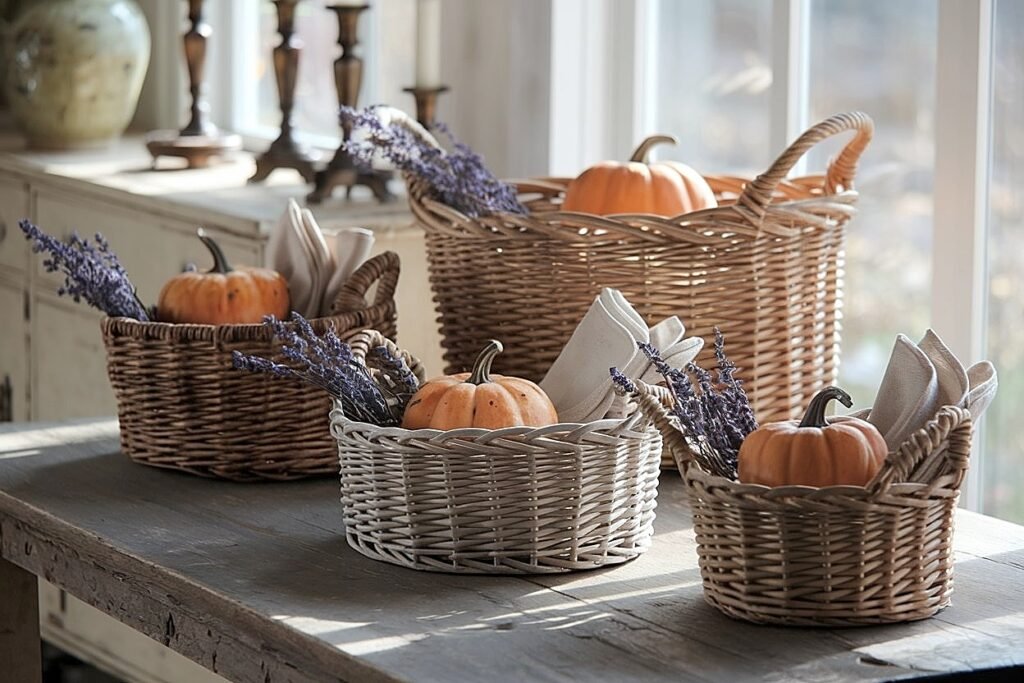
This website contains affiliate links, and some products are gifted by the brand to test. As an Amazon Associate, I earn from qualified purchases. Some of the content on this website was researched and created with the assistance of AI technology.
Key Takeaways
- Pick lidded, low, or handled wicker with a stable base and food-safe liners; keep profiles low so guests can reach platters without dodging stems.
- Wire short lavender bundles (3–5 stems, 4–5 inches), anchor them into a hidden structure, and layer matte textures (linen, olive, pewter) for polish.
- Repeat one ribbon and one metal across baskets, buffet, and sideboard for a calm, cohesive look that feels intentional, not improvised.
Arranging Lavender in Wicker Baskets for Thanksgiving Buffets starts with one non‑negotiable: function first, beauty threaded through it. A buffet is a working surface—steam, sleeves, serving spoons—and lavender should steady the chaos, not add to it. I use baskets to impose order, hide mechanics, and move décor in one lift when a hot dish arrives.
I’ve styled everything from narrow condo sideboards to sprawling farmhouse spreads, and the pattern holds: low profiles, disciplined color, and short, wired lavender sprigs that perfume the air without touching food. When wicker, linen, and pewter hum together and the mechanics disappear, the room exudes calm—and guests move like they’ve rehearsed it.
Quick scan: The five phases keep your lavender wicker baskets cohesive across windows, sideboards, hutches, consoles, and benches. Table on larger screens; accordion on phones.
| Theme | Focus Areas | Furniture & Window Cues | Pro Tips |
|---|---|---|---|
| 1. Preparation PlanningMaterials |
|
|
|
| 2. Structure ShapeSupport |
|
|
|
| 3. Styling TextureFragrance |
|
|
|
| 4. Coordination CohesionSafety |
|
|
|
| 5. Finishing Touches ExperienceContinuity |
|
|
|
1) Preparation
- Select wicker baskets & liners
- Dry lavender for color & scent
- Pick fragrance-rich varieties
- Prep near windows for airflow
- Store stems in sideboards
- Stage gear on benches
- Keep stems long to trim later
- Match basket tone to table
- Lay tools by task flow
2) Structure
- Layer base, mid, crown stems
- Even spacing = rhythm
- Moss/mesh for support
- Edge/corner anchors
- Overflow to a console
- Angle toward light
- Structure first, style second
- Vary heights for motion
- Unify stem direction
3) Styling
- Lavender + pumpkins + herbs
- Layer candlelight
- Muted fall palette
- Use windows for shadow play
- Mirror on hutches
- Intentional reflections
- Odd-number groupings
- Alternate linen/burlap
- Keep lavender dominant
4) Coordination
- Unify buffet & table tones
- Plan food-safe zones
- Balance natural/ambient light
- Match linens to sideboards
- Use consoles near seating
- Turn scents from mains
- Keep florals above serving height
- Limit metals to two
- Echo hue via napkins
5) Finishing Touches
- Tags, ribbons, lace
- Guest favors
- Winter transition plan
- Favors staged on sideboards
- Shoot near windows
- Scent at entries
- Sachets as takeaways
- Swap pumpkins → pinecones
- Golden-hour photos
How to Choose the Right Wicker Basket for Lavender Thanksgiving Displays
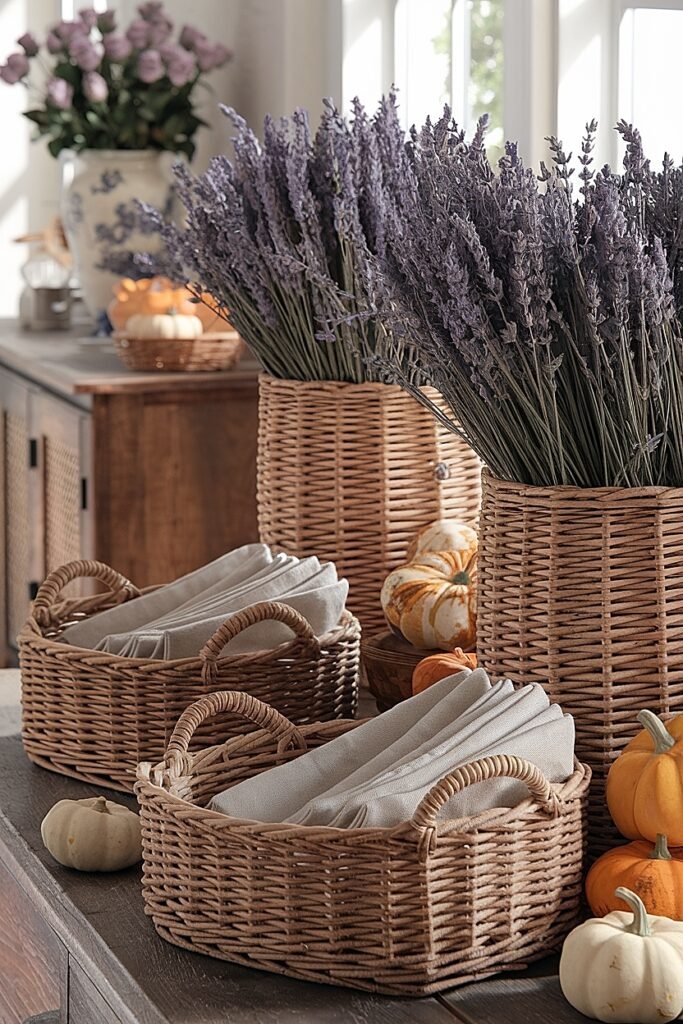
Start with structure. I reach for baskets with a flat, weighty base and tight weave so stems won’t fall through. Low ovals corral napkins and favors; medium handled rectangles hold jar clusters; lidded bread baskets keep crumbs in check. Dark honey or weathered ash tones ground lavender’s cool bloom; bright orange wicker fights the palette.
Scale it to the job. For a narrow buffet, I cap depth at 8–10 inches so traffic flows; on a farmhouse sideboard, a 14–16 inch shallow tray basket reads generous without towering. Test grip: lift fully loaded—if the frame flexes, pass. I also check for hidden splinters at rim edges where ribbon and lace would snag.
Choose flat-bottom, tight-weave wicker in muted tones; size shallow and wide for buffets; ensure the rim is smooth for ribbons and fabrics. For a full buffet blueprint that pairs perfectly with your baskets, see Styling a Rustic Lavender Thanksgiving Buffet Table—and if this guide helps, share it with friends who love a calm, fragrant holiday spread. More botany next—keep reading for variety picks that behave in baskets.
What Are the Best Lavender Varieties for Wicker Basket Thanksgiving Arrangements?
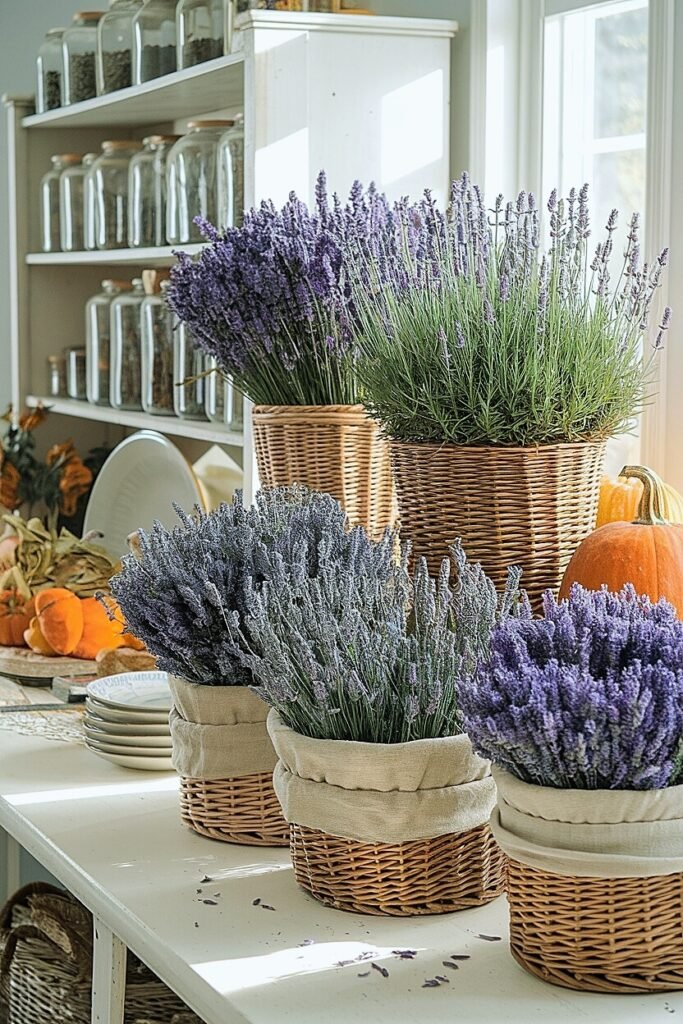
- English Lavender (Lavandula angustifolia): My basket workhorse. Short internodes, tight buds, refined aroma—ideal near plates. It wires cleanly into 3–5 stem micro-bundles and sheds minimally if you tape and trim. Color reads dusky under warm light, so it plays well with bone linens and pewter saucers. I use English along rim lines, napkin caddies, and favor baskets where guests experience the scent close-up without a perfumed blast.
- Lavandin (Lavandula x intermedia): Longer stems, abundant buds, and that elegant sweep you need for basket backlines. I cut to 8–12 inches, then arc 45 degrees for movement. Aroma has a fresher, slightly camphor lift—great for airy spaces or near entry drafts. Use Lavandin as the “spine” in handled or lidded baskets; punctuate with short English clusters for massed scent and tidy silhouettes.
- French/Spanish Lavender (Lavandula stoechas): Sculptural bracts bring personality when used sparingly. In baskets, I seat Stoechas as a focal—one or two stems by the handle knot or in a mini cloche inside the basket. Keep it away from steam and sleeves; the bracts are delicate. Its whimsical shape photographs beautifully, making small doses worth the care.
English for detail and proximity, Lavandin for sweep and structure, Stoechas for sculptural moments. More mechanics ahead—keep reading to build a basket structure that hides your secrets.
How to Build a Balanced Lavender Thanksgiving Basket Arrangement Structure
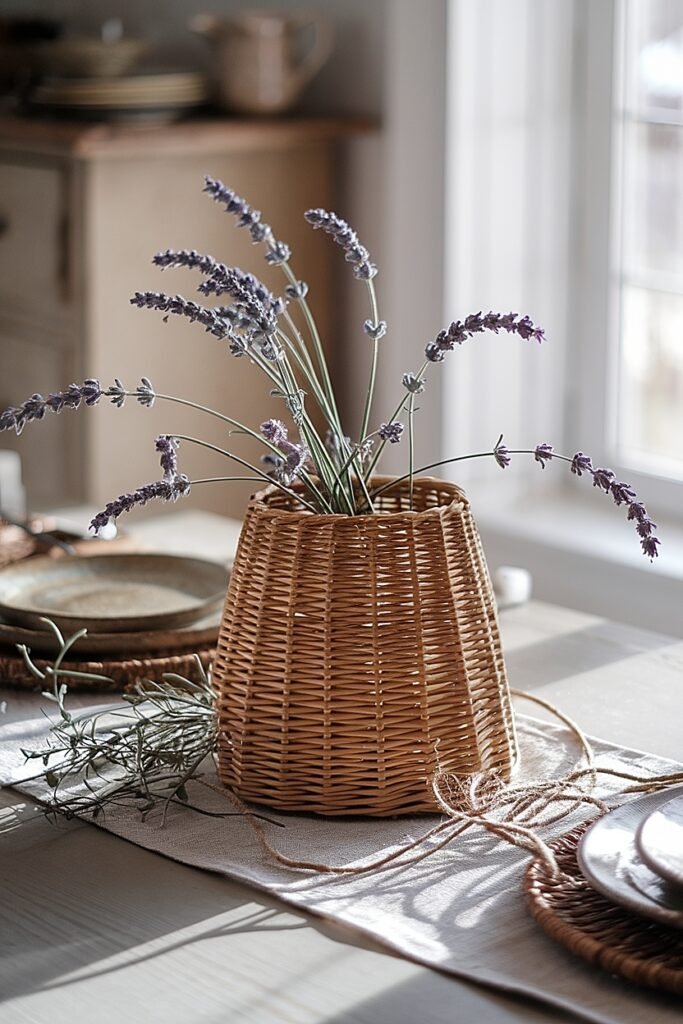
Think in layers: liner, weight, structure, cover. I line first with a fitted plastic or silicone mat to keep moisture out of the wicker. For ballast, I add flat river stones or a ceramic tile—weight prevents tipping when guests lift napkins or favors. On top, I place a foam alternative: a dry floral brick or a nest of balled chicken wire secured to the rim with zip ties.
Hide the hardware with a thin bed of olive or seeded eucalyptus. Now wire your lavender micro-bundles and insert at 45 degrees, working from the back edge forward to keep the profile low. Reserve the front edge for the shortest sprigs so sleeves glide over, not through, the design.
Liner for protection, ballast for stability, wire or foam for anchoring, greens for cover, then short lavender bundles set on angles for line and scent. More polish next—keep reading for basket linings that look rustic, not rough.
Ways to Line Thanksgiving Wicker Baskets for a Polished, Rustic Finish
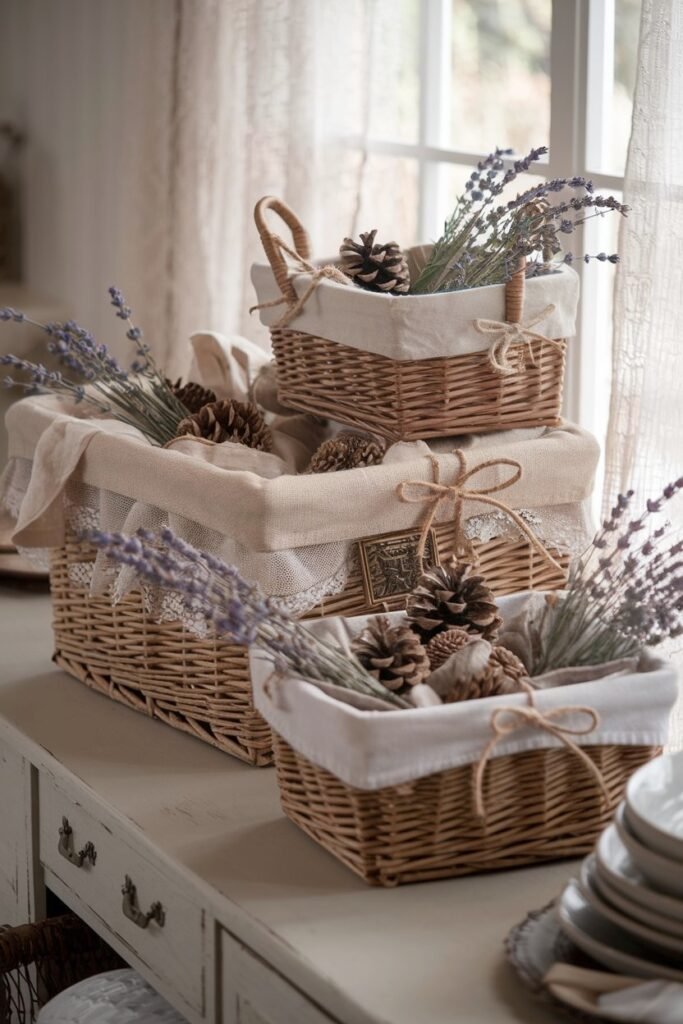
- Bone Linen Insert: Cut a custom rectangle, fold a 1-inch hem, and weight the base with a thin felt pad. Linen’s matte finish flatters lavender and reduces glare; it also grips jars and saucers so nothing skates when the line surges. Spot-cleanable and timeless.
- Backed Burlap Sleeve: Use burlap with a muslin backing to stop fiber shed. I create a slipcover that hugs the interior and flips ½ inch over the rim. Burlap reads authentically rustic, and the backing protects food-adjacent zones. Add a thin ribbon at the fold to refine the edge.
- Quilted Cotton Pad: For bread or napkins, a quilted base keeps warmth and adds soft structure. Choose ivory or sage, not bright white. I tuck a micro lavender sprig into a stitched corner and keep botanicals off food using a folded linen flap as a barrier.
Choose matte, lined textiles that protect wicker and control shed; finish edges cleanly and echo your ribbon color. More color and texture next—keep reading to layer florals and foliage without crowding plates.
Ideas for Layering Lavender with Dried Florals and Foliage in a Thanksgiving Wicker Basket
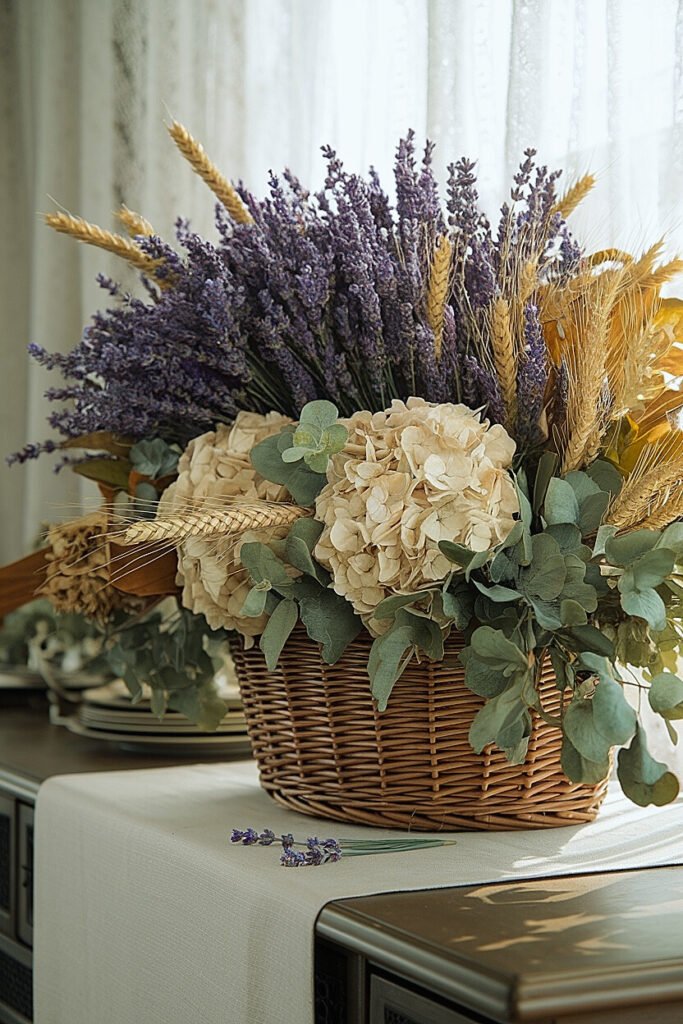
- Wheat Fans: Lay 8–10 inch wheat sheaves horizontally as a low fan, then stitch lavender bundles at 45 degrees across the grain. The straw gold warms lavender’s cool tone without height.
- Hydrangea Wedges: Seat one dried hydrangea head in the back-left corner and one in the mid-right, then arc lavender between them. Hydrangea adds mass; lavender supplies motion.
- Statice Dots: Tuck 4–6 inch statice segments beneath lavender lines to create papery lightness. Favor cream or dusty lilac for gradient over purple-on-purple weight.
- Dusty Miller Pads: Feather small pads where stems enter the structure to hide mechanics and mirror lavender’s bloom. Use sparingly near food zones.
- Juniper Sprigs: Add a few juniper tufts with blue berries at the rim. The berry blue bridges lavender’s hue and gives winter whisper without adding height.
Pair one mass flower (hydrangea), one structure (wheat), and two cool-toned foils (statice, dusty miller/juniper) to let lavender lead. More cohesion next—keep reading to coordinate baskets with table settings gracefully.
Ways to Coordinate Lavender Baskets with Thanksgiving Table Settings
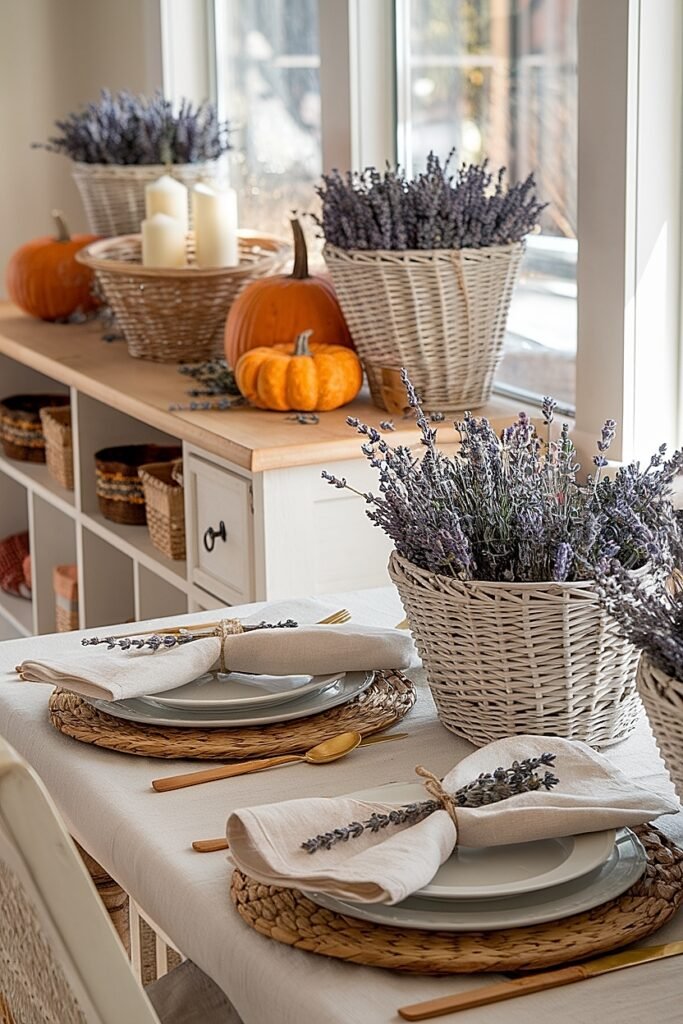
I treat baskets as the chorus and the place settings as soloists. The throughline: ribbon, metal, and herb. Match the basket ribbon to your napkin tie—velvet in eggplant or linen in bone—and keep metal consistent (pewter or antique brass). Slide a single English lavender sprig through the napkin ring and echo that same sprig taped inside the utensil basket sections.
For menus or labels, mount cards on bone cardstock and clip them to basket rims with brushed metal clips. The repetition reads intentional in photos and keeps guests oriented. Place a petite lavender bundle at the bread basket fold; for scent-sensitive guests, seat them away from any scented candles and keep baskets nearest them unscented.
Repeat one ribbon and one metal across baskets and place settings; echo a micro lavender sprig at each station for a composed, guest-friendly flow. More centerpiece strategy next—keep reading to design a basket that anchors the buffet without blocking hands.
Ways to Design a Lavender Basket Centerpiece for the Thanksgiving Buffet Table
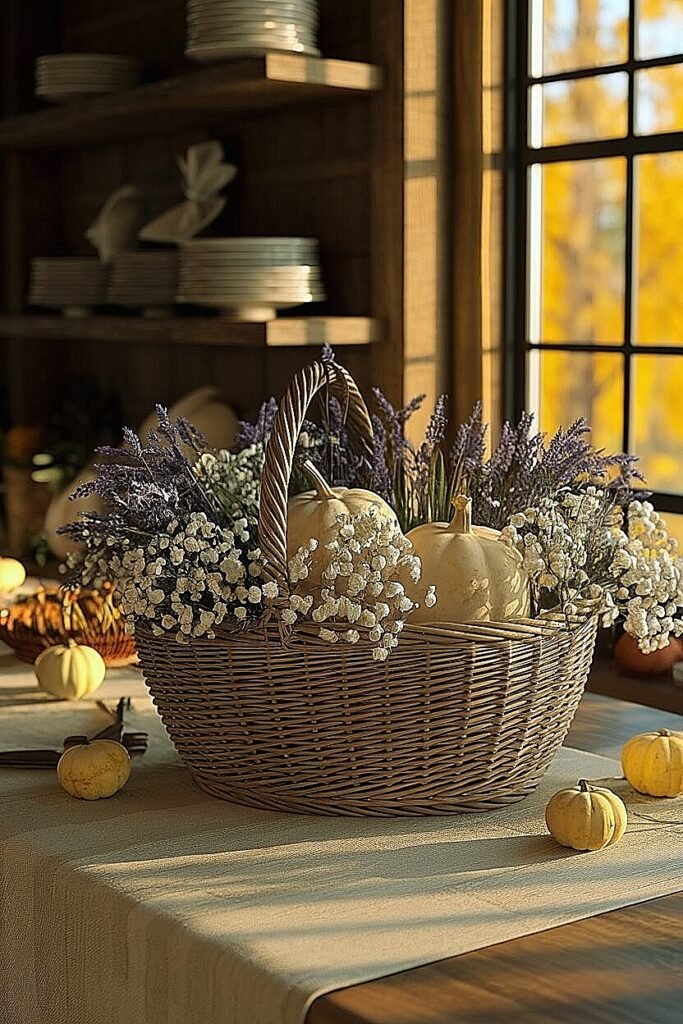
- Low Oval with Twin Lanes: Build a shallow oval basket with a split composition—lavender spine down the center and negative-space lanes on both sides for platters. Add figs on pewter saucers tucked into the greens for appetite cues.
- Handled Rectangle with Corner Weight: Cluster hydrangea wedge + wheat fan at one back corner; drape lavandin along the handle line; finish with English clusters along the front rim. This pulls the eye across the table without height.
- Lidded Bread Basket “Halo”: Keep bread protected under the lid; create a detachable lavender collar ring that wraps the lid’s perimeter. When you lift the lid, the collar stays put—no floating flowers in the brioche.
- Duo Baskets on a Tray: Two small baskets corral LEDs, jars, and favors on a single wooden tray. Lavender dots the perimeters; when the turkey arrives, one lift clears space.
- Cloche-in-Basket Moment: Seat a mini cloche over a Baby Boo pumpkin inside a basket; ring with a slim lavender wreath. It’s a protected focal that can slide to a sideboard during service.
Keep profiles under eight inches, preserve platter lanes, and design for lift-and-shift. Lavender should guide the eye, not block the meal. More finesse next—keep reading to finish baskets with details guests actually notice.
Ways to Add Finishing Touches to Lavender Basket Thanksgiving Displays
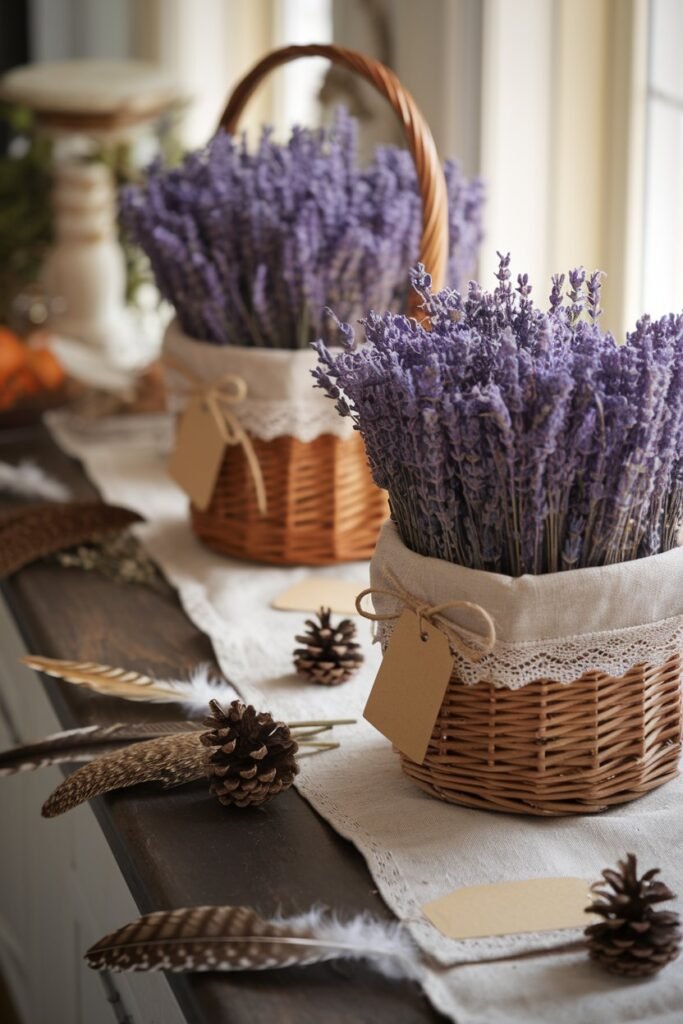
I aim for restrained repetition. A narrow velvet tail tied to each basket handle, a pewter bell at one corner, and a discreet herb tag—rosemary, thyme, sage—handwritten in graphite. I dab museum wax beneath heavier accents so nothing skitters when the line gets energetic.
Edge control matters. I place felt dots under basket bases to protect wood and keep them from drifting. Any exposed foam or wire vanishes under dusty miller pads or olive leaves. If you photograph at dusk, angle baskets toward the window or a mirror to catch that soft, golden wash over lavender’s bloom.
Add one ribbon, one tiny metal accent, and tidy edges with leaves; stabilize bases and angle for light. More logistics next—keep reading for where to park baskets so the room flows.
What Are the Best Placement Ideas for Lavender Thanksgiving Baskets
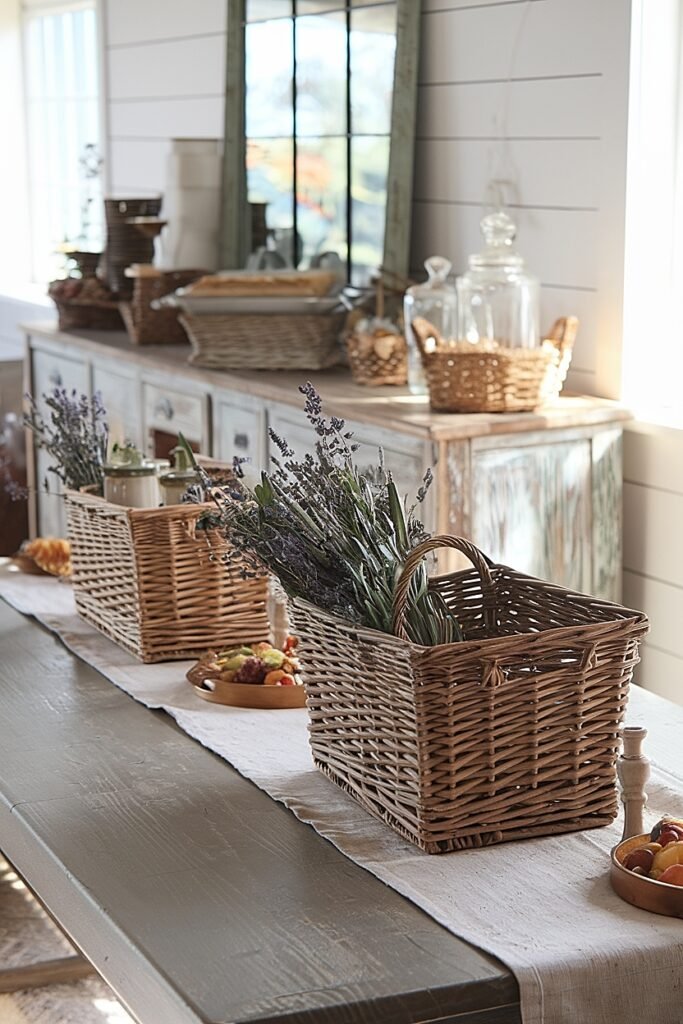
- Entry Console Staging: Park a medium handled basket with favors (mini lavender bundles in jars) and a small sign. It cues the lavender story early without congesting the buffet.
- Bench Utility Zone: A lidded basket for extra napkins and a caddy basket for utensils keep refills off the buffet. Tie the same ribbon around rims to stitch the look across the room.
- Sideboard Glow Line: A shallow tray basket holding frosted jars with LEDs and short lavender tufts extends ambiance and gives overflow surface for sides when the main table gets crowded.
- Hutch Mirror Echo: A low basket with a lavender collar sits below the hutch mirror; mercury votives in front wash the blooms with gentle light. It visually links hutch and buffet.
- Buffet Bookends: Two low oval baskets at buffet ends—one with bread and linen, one with fruit on saucers—frame the service run and keep traffic moving. Both use short English sprigs to prevent sleeve snags.
Place baskets where they support flow—console, bench, sideboard, hutch, and buffet ends—with consistent ribbon and metals tying the spaces together. There’s more nuance throughout—keep reading and adapt these moves to your room’s light, layout, and guest count.
Conclusion
Lavender in wicker baskets shines when form serves function. Choose stable, tight-weave baskets in muted tones; line them with matte, food-safe textiles; and anchor short, wired sprigs into a hidden structure. Layer wheat, hydrangea, statice, and silver-green leaves for texture without height, echo ribbon and metal across the room, and park baskets where they smooth the guest journey. Corral accents on trays for one-lift resets, keep flames low and off the food zone, and protect surfaces with felt and liners. Do that, and your buffet will smell calm, look composed, and welcome second helpings without a single elbow apology.
This website contains affiliate links, and some products are gifted by the brand to test. As an Amazon Associate, I earn from qualified purchases. Some of the content on this website was researched and created with the assistance of AI technology.
